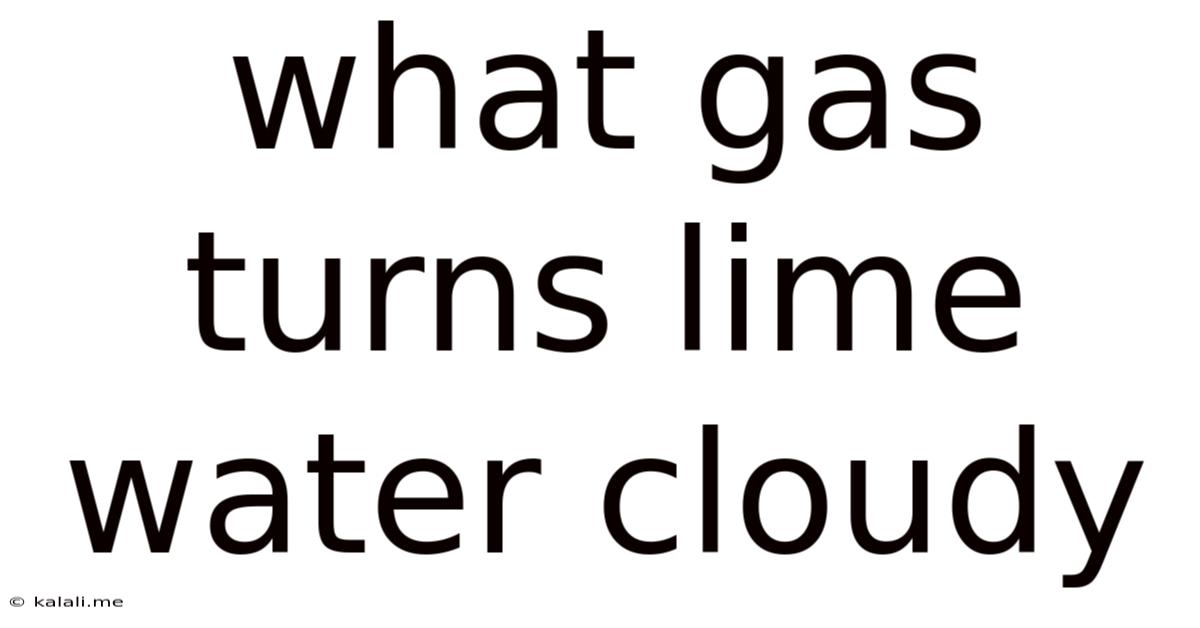What Gas Turns Lime Water Cloudy
Kalali
Jun 11, 2025 · 2 min read

Table of Contents
What Gas Turns Limewater Cloudy? A Comprehensive Guide
Limewater, a saturated solution of calcium hydroxide (Ca(OH)₂), is a common chemical used in science experiments and demonstrations. Its characteristic reaction with a specific gas makes it a valuable tool for identifying that gas. This article explores the gas responsible for turning limewater cloudy and the underlying chemical process involved. Understanding this reaction is fundamental for anyone studying chemistry or simply curious about chemical reactions.
Carbon Dioxide: The Culprit Behind the Cloudiness
The gas that turns limewater cloudy is carbon dioxide (CO₂). When carbon dioxide is bubbled through or mixed with limewater, a chemical reaction occurs, producing a cloudy white precipitate. This reaction is a classic example of a precipitation reaction.
The Chemistry Behind the Reaction
The reaction between carbon dioxide and limewater is a two-step process:
-
Formation of Calcium Hydrogencarbonate: Initially, carbon dioxide reacts with calcium hydroxide to form calcium hydrogencarbonate (Ca(HCO₃)₂). This is a soluble compound, meaning it dissolves in water and remains clear. The equation for this reaction is:
Ca(OH)₂(aq) + 2CO₂(g) → Ca(HCO₃)₂(aq)
-
Precipitation of Calcium Carbonate: However, if sufficient CO₂ is added, or if the solution is left to stand, the calcium hydrogencarbonate can decompose into insoluble calcium carbonate (CaCO₃), water (H₂O), and carbon dioxide (CO₂). This insoluble calcium carbonate is what causes the limewater to become cloudy. The equation is:
Ca(HCO₃)₂(aq) → CaCO₃(s) + H₂O(l) + CO₂(g)
The overall reaction, combining both steps, can be simplified to:
Ca(OH)₂(aq) + CO₂(g) → CaCO₃(s) + H₂O(l)
Identifying Carbon Dioxide
This reaction forms the basis of a simple test to identify the presence of carbon dioxide. By bubbling an unknown gas through limewater, a change in appearance from clear to cloudy white indicates the presence of carbon dioxide. This test is frequently used in experiments related to respiration, combustion, and the decomposition of carbonates.
Practical Applications and Further Exploration
The reaction between carbon dioxide and limewater has several practical applications, including:
- Testing for CO₂ in exhaled breath: This classic experiment demonstrates the presence of carbon dioxide in our exhaled breath.
- Detecting CO₂ in fermentation processes: The cloudiness can indicate the production of CO₂ during fermentation.
- Understanding the formation of limestone: The reaction is crucial in understanding the geological formation of limestone and other carbonate rocks.
- Water purification: Lime is sometimes added to water to neutralize acidity and remove impurities, though the resulting calcium carbonate might require further treatment for optimal water quality.
This reaction is a fundamental concept in chemistry, providing a clear and visually appealing demonstration of chemical reactions, precipitation, and gas identification. By understanding the chemical processes involved, we can appreciate its significance in both scientific experiments and natural processes. Further research into related topics like acid-base reactions and solubility will enhance your understanding of this essential chemical reaction.
Latest Posts
Latest Posts
-
Spoon Gets Hot In A Bowl Of Soup
Jul 02, 2025
-
How Many Cups In A 16 Oz Sour Cream
Jul 02, 2025
-
How Many 1 4 Teaspoons Are In 1 Teaspoon
Jul 02, 2025
-
How Many Tbsp In A Dry Ounce
Jul 02, 2025
-
How Do You Say Grandparents In Spanish
Jul 02, 2025
Related Post
Thank you for visiting our website which covers about What Gas Turns Lime Water Cloudy . We hope the information provided has been useful to you. Feel free to contact us if you have any questions or need further assistance. See you next time and don't miss to bookmark.